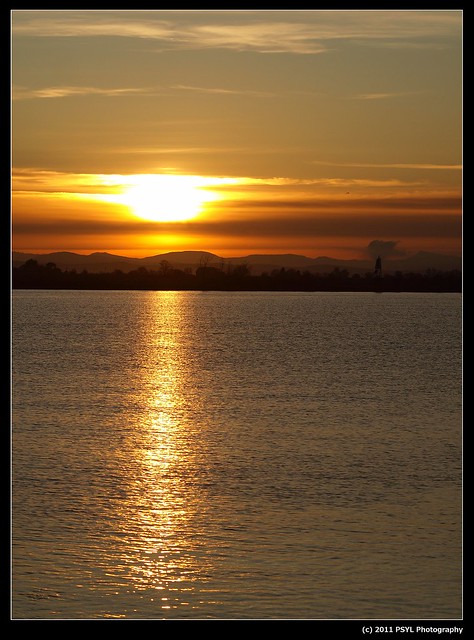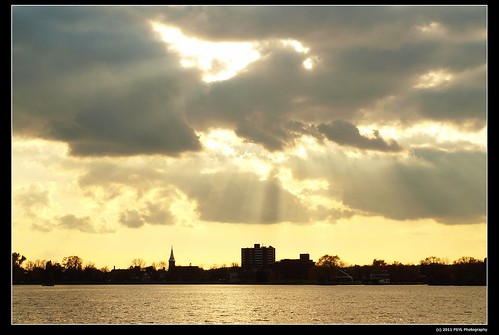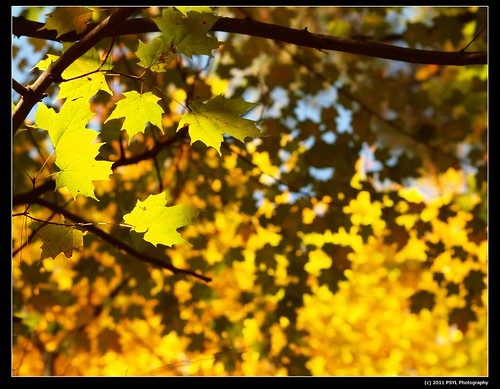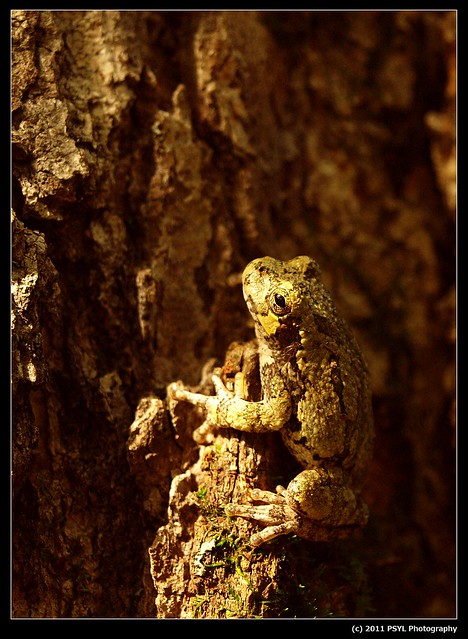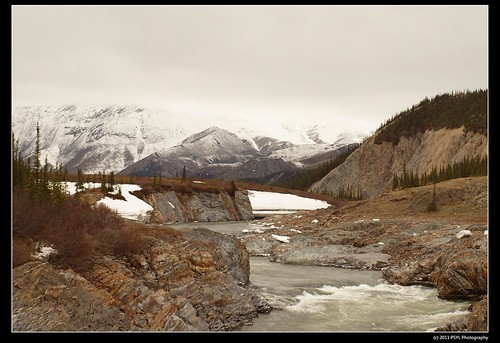"There are some who can live without wild things, and some who cannot. These essays are the delights and dilemmas of one who cannot" - Aldo Leopold
2011/12/31
Probably the last post of 2011...
2011/12/30
False alarm


I snapped a photo of the dark and yet beautiful starry night in case that was true. Unfortunately, it was only a temporary power outage and was restored back to order shortly.
I don't think I have yet gotten a good night sleep since coming back to BC (especially with our terrible, noisy, and rude neighbors upstairs).
2011/12/29
Arctic ground squirrel in Ivvavik National Park
They are found in all the places I was at this summer and quite entertaining to watch sometimes.

We found this baby on our second hike to Inspiration Point. It was hiding underneath a rock and making threatening noises.
2011/12/28
Test shot of Nikon Coolpix S4100

Really wish the weather would get better at least once before I leave BC next month.
2011/12/26
Abstracts from conferences
-----
"Examining the roost selection of Formosan Tube-Nosed Bat, Murina puta, in the Taipei Zoo Forest," Taiwan Tech Trek 2008 Academic Conference, August 2008.
From June to August of 2008, we studied the roost characteristics of the Formosan Tube-Nosed Bat, Murina puta. Roost conservation is important for M. puta, because they are considered a threatened species and endemic to Taiwan. Our sampling area was the Taipei Zoo Forest, a temperate forest region spanning 14.4 hectares. To capture the bats, harp nets were left overnight in the forest. Radio transmitters were glued to the captured bats, which were released at dusk, their usual feeding time. Upon release, the bats were tracked for a maximum of twenty-one days in which the location, temperature, luminance, and moisture of their roost area were recorded. To prevent disruption of bat roosts, data such as roost length, area, and height were collected after the bats moved to other locations. Upon analyzing our data and past data, we found that tube-nosed bats prefer to roost in Alpinia speciosa K. schum second to dead tree ferns, Cyathea lepifera, and its primary roost selection. This is the first study in Taiwan to track bats in their specific roosts, and thus can be used as an example for future research on other bat species. Through this study, we can make more knowledgeable decisions for the preservation of M. puta and conservation of its natural habitats in Taiwan.
-----
“Primary investigation on the breeding biology of Taiwan Barbet (Megalaima nuchalis) in Taipei Botanical Garden,” Taiwan Tech Trek 2009 Academic Conference, Taiwan, August 2009.
The breeding biology of Muller’s Barbet (Megalaima nuchalis) was studied in Taipei Botanical Garden (TBG), Taipei City, Taiwan during the breeding season of 2009 (ongoing). The breeding activities of Muller's Barbet began in April and likely to end in September based on last year’s observation. Muller’s Barbet is a monogamous species, and both parents share duties in nest excavation, egg incubation, and chick rearing. The average clutch size was 3.07 eggs (n = 13), and it took an average of 15.8 incubation days (n = 5) for the eggs to hatch. Once hatched, the nestlings required an average of 28.0 brooding days (n = 4) for them to develop and fledge. On average, 56.7% of the eggs successfully hatched new nestlings (n = 10), and the mean fledgling success rates were 52.4% (n = 7) and 77.8% (n = 7) relative to the number of eggs laid and number of nestlings hatched, respectively. Overall, out of the 13 clutches with eggs, 6 clutches successfully produced one or more fledglings. In TBG, a total of ten nest trees were located, and the predominately tree species was Cinnamomum camphora (40%). Most of the nest cavities of Muller’s Barbets were located inside dead branches or trunks of either living or dead standing trees, with the exception of a nest cavity in a living branch of a Cordia dichotoma tree. Overall, this study provides a source of information for future researches on the ecology of Muller’s Barbet and the effect of green spaces on urban biodiversity.
2011/12/23
Strolling in Terra Nova and seeing a lifer - Greater White-fronted Geese
2011/12/22
2011/12/19
Burning bright
Here were some photos from the South Dyke. Did I mention there are many feeders along the trail now - compared to before? I guess people like to watch the birds and dogs at the same time.
2011/12/18
Back to BC
2011/12/09
Some of the birds in Ivvavik National Park
I can't wait to go back to BC to relax (just a bit...still a lot of work to do back home) and do some birding - I have seen a lot of Snowy Owls photos by Lower Mainland photographers that I am feeling very jealous of. Birding is not particularly interesting here, or maybe I am just way too busy.
Here are some of the bird photos that I took this past summer in Ivvavik.
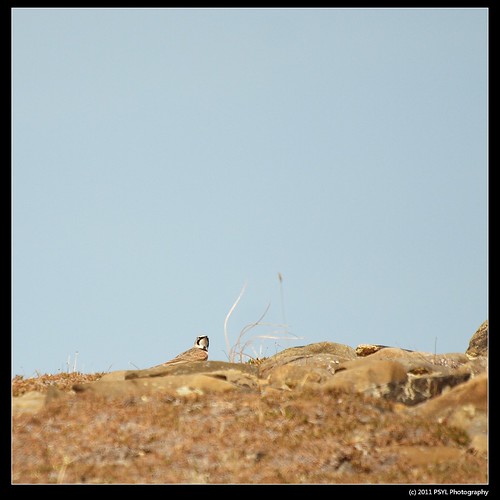
Horned Lark (Eremophila alpestris) - they were found in alpine tundra areas - grassy or rocky with very little vegetation.
2011/12/01
Porcupine caribous in Ivvavik National Park
Sometimes after working on my assignment about my thesis project, I take a break by watching the latest documentary by BBC called Frozen Planet. It's very relevant to me because it is about the polar regions and some of the scenery from the Arctic reminds me of my summer. The episode I am watching now is titled "Autumn" and one of the segments is about the fall caribou migration in north Canada (I watched this episode from this uploaded video because I am not in UK).
This reminded me of June 13, a day when an astonishing number of caribous moved on the hills on the other side of the Firth River. It was definitely one of the most memorable wildlife moments in my life.
2011/11/26
Twilights
2011/11/20
Walking along Jackson Creek
2011/11/13
Goldenrod Sunset

2011/11/08
Shrike behind building
 Just before lunch today, the fire alarm went off in the building and everybody was evacuated. I decided to go to the gravel hill behind building. I sat on the hill for a while thinking about stuff, and when I was about to leave, a bird flew from one of the trees and landed nearby. I only had my kit lens and I did the best I can with what I got, but the bird did not seem too typical. Looking closer, I realize it was a shrike - what species, I can't tell for sure. But from the bottom left photo, it looks like a juvenile.
Just before lunch today, the fire alarm went off in the building and everybody was evacuated. I decided to go to the gravel hill behind building. I sat on the hill for a while thinking about stuff, and when I was about to leave, a bird flew from one of the trees and landed nearby. I only had my kit lens and I did the best I can with what I got, but the bird did not seem too typical. Looking closer, I realize it was a shrike - what species, I can't tell for sure. But from the bottom left photo, it looks like a juvenile.Definitely the most exciting part of the day!
2011/11/07
Murmuration
2011/11/06
Early sunset
Biked to Little Lake again before I went to do a quick grocery run for the week.
Ganaraska Forest & Biked to Lakefield sewage lagoon
This morning, I helped a lab-mate with her research project in Ganaraska Forest. It is a very nice forest - quiet and peaceful. I'd imagine it is livelier in the summer with all the birds and people, but I think I enjoy this time of the year more.

2011/10/31
2011/10/30
Trent's Blue Trail
Below are some of the photos I took this afternoon.

2011/10/29
House Centipede
2011/10/27
Successful Owl-Banding Last Night
 Inside the banding cabin - nice and homely.
Inside the banding cabin - nice and homely.2011/10/25
Rainy/Sunny Day
While this was going on, I was using the computer facing the window and I could see the small invasions of chickadees, sparrows, and juncos to the trees right outside my window. I also spotted a White-breasted Nuthatch, so overall, it was an interesting morning.
In the afternoon, while it was still sunny, I went out to get some grocery and took my camera with me. I took some photos of the birds feeding from the wet ground.
 Chipping Sparrow (Spizella passerina)
Chipping Sparrow (Spizella passerina)2011/10/23
First time visitng Miller Creek Wildlife Area
However, biking to MCWA was tougher than I thought. It is probably because I haven't bike in awhile, or that there are many "hills" along the way, or that there are no bike trails and I had to bike along 70km-limit lanes. Nonetheless, I surprisingly found the place about an hour later without getting lost at all.
 Along the way, I saw this snake in the middle of the road with some blood around it. At first I thought it was dead, but a closer look showed that it was still alive. I was unsure if I should leave it be and have other cars end its life sooner or bring it aside and hopefully it will still survive. I chose the latter.
Along the way, I saw this snake in the middle of the road with some blood around it. At first I thought it was dead, but a closer look showed that it was still alive. I was unsure if I should leave it be and have other cars end its life sooner or bring it aside and hopefully it will still survive. I chose the latter.Getting a bike and biking along Trans-Canada trail
After getting my bike and air pumped into the tires, I went for a bike ride to Jackson Park and then the Trans-Canada trail.
2011/10/19
School stuff
I just handed in an assignment for a class - a "letter of intent" for my M.Sc thesis project. It gives people an idea of what I am working on.
-------------------------------------------------------------------------------------------------
The interaction between dioecious plants and their associating pollinators is poorly known, especially in Arctic ecosystems where plants and insects are extremely sensitive to potential spatial and temporal mismatches. Dioecism in flowering plants is a sexual system where a plant bears either female or male flowers, which allows for the selection of the most favourable genetic combination. For many dioecious plants, the males and females in a population are observed to segregate from each other along an environmental gradient. One of the proposed selective mechanisms causing this spatial segregation of sexes consists of the differences in reproductive investments between males and females [1]. Females require and spend more resources and energy on the productions of ovaries, fruits, and seeds than males that invest primarily on pollen grains. This major difference in reproduction biology indicates that females are more likely to occupy resource-rich habitats than males, resulting in spatial segregation of sexes. The proposed project will select a dioecious plant species and study the biotic and abiotic variations within and between several populations. The variations include female to male ratios, phonological and morphological differences between females and males during the growing season, the resulting fruit set and seed set at the end of the growing season, and the surrounding abiotic environmental factors. The information will be tested for their associations with pollinator richness to determine the effects of pollinator abundance and diversity on the reproductive successes of dioecious females.
In addition to understanding the pollination ecology of dioecious plants, the proposed project will also aim to address the status of pollinators in natural ecosystems across northern Canada. Pollination is an extremely valuable ecosystem service carried out by managed and wild pollinators for many agricultural crops and wild plants. Without pollinators and the plants that depend on them, ecosystems will be reduced or lost, and food security for humans will become seriously jeopardized. Most insect pollinators worldwide are in a state of decline and, because of their importance, there is a growing concern in the ecological community to not only determine the potential drivers causing the declines, but to also develop mitigating solutions [2]. One of the main potential drivers of global pollinator declines is climate change [2]. However, studies pertaining to the effects that climate change has on pollinators in the Arctic, one of the world’s most important ecotones, remains scant. Therefore, the proposed project will also establish baseline knowledge on pollinator abundance and diversity in northern Canada by trapping and identifying pollinators that visit the dioecious plant species of interest.
To fully account for wild pollinator abundance and diversity Arctic ecosystems, the proposed project will be carried out in Ivvavik National Park of northern Yukon: a unique region in the Arctic ecosystem that was unglaciated during the Ice Ages and now has distinct landscapes and biodiversity. The plant species in study will be Shepherdia canadensis, one of the dioecious plant species in the Arctic whose berries are consumed by local First Nations people as well as by wildlife such as grizzly bears. Very little is known about the pollination biology of S. canadensis and the associating pollinators, however, especially given Arctic’s short growing season. Overall, I hypothesize that along an elevation gradient where harsher environmental conditions are found in higher elevations than lower elevations, female S. canadensis will be more dominant in lower elevations and vice versa for the males. Furthermore, I hypothesize that pollinator abundance and diversity will also differ along the elevational gradient and result in different reproductive success rates, such as fruit set and seed set, of the females.
My objectives are to: 1. Establish a baseline inventory of pollinator abundance and diversity in Ivvavik National Park; 2. Determine the sex ratio and sexual dimorphism of dioecious S. canadensis populations in Ivvavik National Park along an environmental gradient (e.g. elevation gradient); and 3. Examine the effects of pollinator abundance and diversity on the reproductive success rates (e.g. fruit set and seed set) of S. canadensis plants in different populations along the environmental gradient. This project is important and relevant in terms of its fundamental goals of understanding the effects of sexual selection by pollinators on the ecology and evolution of dioecious plants and the impacts of climate change on wild pollinators and plants in Arctic ecosystems.
[1] Bierzychudek, P, Eckhart, V. 1988. Am. Naturalist. 132: 34; [2] Potts, S. et al. 2011. TREE. 25: 345.
-------------------------------------------------------------------------------------------------And then today we had a lecture on how to communicate to the general public by one of Trent's professors.
Here are some points, quotes, and articles that I thought was pretty good:
- Scientific research is like putting a jig-saw puzzle together without the picture on the cover box, there will always be pieces of uncertainty.
-There is an ethical justification for conservation biology - can we knowingly allow a species to die off? Human survival depends on many species, and now other species' survival depend on us!
-"The bird and bees, however, beg to differ. Myriad wild species are showing polward shifts in their distribution and changes in the timing of breeding and flowering - an unmistakable biological footprint."
-Tracking long-distance songbird migration by using geolocators by Bridget Stutchbury and colleagues.
-Climate dominoes tumble slowly by James Schaefer.
-Ecological science and sustainability for the 21st century by MA Palmer and colleagues.
-Preparing for an interview - know the goals of the interview and the reporter, anticipate tough questions, identify other experts, know the headlines, be concise, conversational, and catchy, and don't repeat the reporters' words.
-Take control the direction of the interview by using phrases:
- "Yes...in addition..."
- "No...let me explain..."
- "I don't know that...but I do know..."
- "The real issues are ..."
- "What you are really asking is..."
- "Let me put it in a different perspective ..."
2011/10/17
2011/10/14
Visiting Algonquin this weekend
2011/10/11
2011/10/10
Northern Saw-whet Owl banding
The project focuses on Northern Saw-whet Owl (Aegolius acadicus), the smallest owl in eastern North America, and bands them every October during their winter migration down south. We set up mist nets at Trent's James McLean Oliver Ecological Centre and used playbacks to attract these curious birds. We check the nets every 30 minutes and start from sunset until midnight.
Yesterday we caught four owls in total and below are some photos from last night.
2011/10/09
Autumn in Jackson Park
2011/10/08
Friday before the long weekend
And today, I brought it back to school (along with the lens) and took photos of it on the dead yarrow.
 Don't know what species this is, but it is still pretty cool-looking.
Don't know what species this is, but it is still pretty cool-looking.2011/10/06
New place to bird-watch at Trent

Unfortunately I didn't bring my telephoto lens today. So I will have to try to take bird photos next time. The top left photo was a Turkey Vulture flying over me, thinking I am dead or something. Nope, still alive.
Also, I signed up for owl banding on this (and the next) Monday but it was drizzling in the afternoon so it was cancelled. And now the weather forecast predicts good weather throughout the long weekend. Argh!
2011/10/02
Walking along Otonabee River and checking out Head of the Trent
In the morning though, it was windy, cloudy, and cool outside. But the sky cleared in the afternoon and it was beautiful then. Since I am not a fan of large crowds anyways, I decided to take my time and slowly walk along the Otonabee River and towards Trent.
 Clear sky
Clear sky2011/09/29
Treefrog and Porcupine
While doing the point-quarter sampling method, we saw a little Gray Treefrog on the tree the students were measuring.
2011/09/26
Presqu'ile Provincial Park - Part 2
2011/09/25
Presqu'ile Provincial Park - Part 1
I went a little bit overboard with photo taking today, so today will be split into two parts.
2011/09/24
First Annual Purple Onion Festival
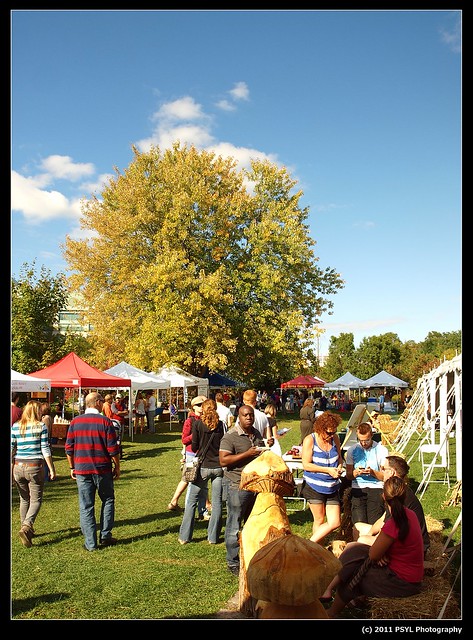
2011/09/23
Animals from Trent's drumlin
Actually, I can talk about the alternating rainy-sunny days that have been going on this week. Or that I went to a M.Sc student thesis defense about her project on Chimney Swifts on Tuesday. Or that I led my first ever lab in Plant Ecology to a drumlin next to the campus to teach students how to conduct plant sampling.
Yesterday was pretty fun too, when the AAA club had a meeting and then some of us hiked up to the drumlin to look for birds. There wasn't many birds in the afternoon, but we did saw a few interesting animals.

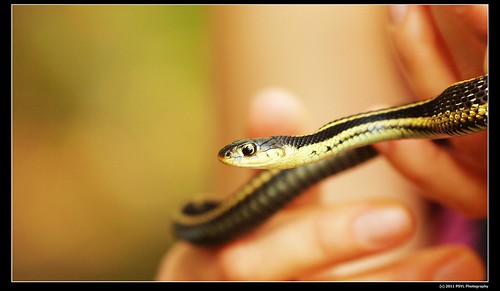
Such as this handsome garter snake.
2011/09/18
Quick update on my life & First AAA trip.
Now, onto today! Today I went on the first field trip with the AAA club to a town north of Peterborough called Lakefield. We went to a sewage pond and tried to spot some ducks. We didn't see many ducks (Mallards and American Black Duck - a lifer that I probably would identify as a Mallard without help), but did saw other birds too, including another lifer, the Chestnut-sided Warbler!
 Lakefield's sewage lagoon
Lakefield's sewage lagoon2011/09/14
Identified insects from last summer
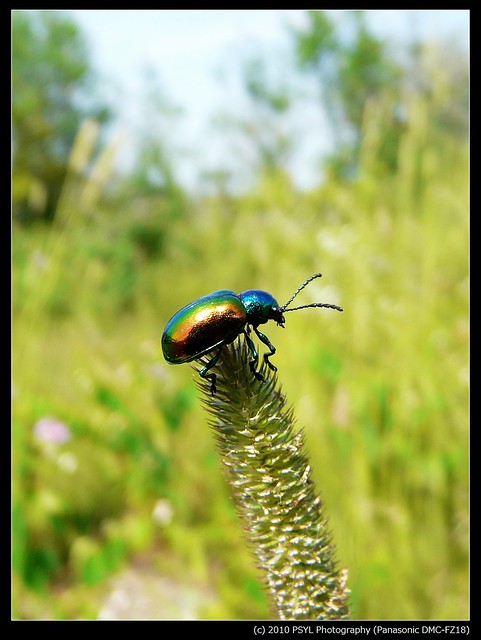
Dogbane Beetle (Chrysochus auratus)
2011/09/12
Rock-climbing on a rock-flipping day

Trent University's Kerr House.
2011/09/10
Revisiting Jackson Park and the day/night before
 Nice weather yesterday.
Nice weather yesterday.2011/09/08
Giant Eastern Crane Fly and other thoughts
Anyways, that was yesterday. Today I mainly stayed in my office, finishing up paperworks, meeting other graduate students, etc. However, the most interesting thing that happened today was probably finding this cool-looking (but dead) crane fly outside the building.


It wasn't too difficult to find the identity of this distinctive critter. It is a Giant Eastern Crane Fly (Pedicia albivitta) with the distinct patterns on its wings. In my field guide, it strangely points out that they have very long and brittle legs, which I thought was a no-brainer (unless the legs are even more fragile compare to other crane flies).
I checked out some of the other graduate students' offices and they had amazing wildlife photos, drawings and artwork on their desks while my (and my office-mates) had empty desks. So I decided to pin this insect as a memorable first insect pinned here in Ontario (actually it is my first pinned insect ever).
Quite a memorable day, I suppose.
2011/09/06
First day of grad school
The orientation was held at the Peter Gzowski College which is also the First Peoples House of Learning, and there were many beautiful artworks on the walls.


